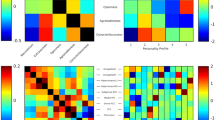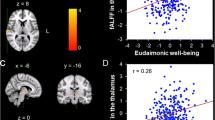Abstract
Neuroimaging techniques such as functional magnetic resonance imaging and positron emission tomography have provided an unprecedented neurobiological perspective for research on personality traits. Evidence from task-related neuroimaging has shown that extraversion is associated with activations in regions of the anterior cingulate cortex, dorsolateral prefrontal cortex, middle temporal gyrus and the amygdala. Currently, resting-state neuroimaging is being widely used in cognitive neuroscience. Initial exploration of extraversion has revealed correlations with the medial prefrontal cortex, anterior cingulate cortex, insular cortex, and the precuneus. Recent research work has indicated that the long-range temporal dependence of the resting-state spontaneous oscillation has high test-retest reliability. Moreover, the long-range temporal dependence of the resting-state networks is highly correlated with personality traits, and this can be used for the prediction of extraversion. As the long-range temporal dependence reflects real-time information updating in individuals, this method may provide a new approach to research on personality traits.
Similar content being viewed by others
References
Eysenck HJ, Eysenck SBG. Manual for the Eysenck Personality Questionnaire:(EPQ-R Adult). Educational Industrial Testing Service, 1994.
Yamasue H, Abe O, Suga M, Yamada H, Inoue H, Tochigi M, et al. Gender-common and -specific neuroanatomical basis of human anxiety-related personality traits. Cereb Cortex 2008, 18: 46–52.
McAdams DP, Pals JL. A new big five. Am Psychol 2006, 61: 204–217.
DeYoung CG, Hirsh JB, Shane MS, Papademetris X, Rajeevan N, Gray JR. Testing predictions from personality neuroscience. Psychol Sci 2010, 21: 820.
Adelstein JS, Shehzad Z, Mennes M, De Young CG, Zuo XN, Kelly C, et al. Personality is reflected in the brain’s intrinsic functional architecture. PLoS One 2011, 6: e27633.
Zuo N, Cheng J, Jiang T. Diffusion magnetic resonance imaging for Brainnetome: a critical review. Neurosci Bull 2012, 28: 375–388.
Song M, Jiang T. A review of functional magnetic resonance imaging for Brainnetome. Neurosci Bull 2012, 28: 389–398.
Eisenberger NI, Lieberman MD, Satpute AB. Personality from a controlled processing perspective: an fMRI study of neuroticism, extraversion, and self-consciousness. Cogn Affect Behav Neurosci 2005, 5: 169–181.
Kumari V, ffytche DH, Williams SC, Gray JA. Personality predicts brain responses to cognitive demands. J Neurosci 2004, 24: 10636–10641.
Suslow T, Kugel H, Reber H, Bauer J, Dannlowski U, Kersting A, et al. Automatic brain response to facial emotion as a function of implicitly and explicitly measured extraversion. Neuroscience 2010, 167: 111–123.
Wei L, Duan X, Yang Y, Liao W, Gao Q, Ding JR, et al. The synchronization of spontaneous BOLD activity predicts extraversion and neuroticism. Brain Res 2011, 1419: 68–75.
Lei X, Zhao Z, Chen H. Extraversion is encoded by scalefree dynamics of default mode network. Neuroimage 2013, 74: 52–57.
Sampaio A, Soares JM, Coutinho J, Sousa N, Goncalves OF. The Big Five default brain: functional evidence. Brain Struct Funct 2014, 219: 1913–1922.
Smith SM, Fox PT, Miller KL, Glahn DC, Fox PM, Mackay CE, et al. Correspondence of the brain’s functional architecture during activation and rest. Proc Natl Acad Sci U S A 2009, 106: 13040–13045.
Ciuciu P, Varoquaux G, Abry P, Sadaghiani S, Kleinschmidt A. Scale-free and multifractal time dynamics of fMRI Signals during rest and task. Front Physiol 2012, 3: 186.
He BJ, Zempel JM, Snyder AZ, Raichle ME. The temporal structures and functional significance of scale-free brain activity. Neuron 2010, 66: 353–369.
He BJ. Scale-free properties of the functional magnetic resonance imaging signal during rest and task. J Neurosci 2011, 31: 13786–13795.
Haas BW, Omura K, Amin Z, Constable RT, Canli T. Functional connectivity with the anterior cingulate is associated with extraversion during the emotional Stroop task. Soc Neurosci 2006, 1: 16–24.
Schaefer M, Knuth M, Rumpel F. Striatal response to favorite brands as a function of neuroticism and extraversion. Brain Res 2011, 1425: 83–89.
Fruhholz S, Prinz M, Herrmann M. Affect-related personality traits and contextual interference processing during perception of facial affect. Neurosci Lett 2010, 469: 260–264.
Farde L, Gustavsson JP, Jonsson E. D2 dopamine rece ptors and personality traits. Nature 1997, 385: 590.
Martin SB, Covell DJ, Joseph JE, Chebrolu H, Smith CD, Kelly TH, et al. Human experience seeking correlates with hippocampus volume: convergent evidence from manual tracing and voxel-based morphometry. Neuropsychologia 2007, 45: 2874–2881.
Chavanon M-L, Wacker J, Leue A, Stemmler G. Evidence for a dopaminergic link between working memory and agentic extraversion: An analysis of load-related changes in EEG alpha 1 activity. Biol Psychol 2007, 74: 46–59.
Chi SE, Park CB, Lim SL, Park EH, Lee YH, Lee KH, et al. EEG and personality dimensions: A consideration based on the brain oscillatory systems. Pers Individ Dif 2005, 39: 669–681.
Matthews G, Amelang M. Extraversion, arousal theory and performance: A study of individual differences in the eeg. Pers Individ Dif 1993, 14: 347–363.
O’Gorman RL, Kumari V, Williams SC, Zelaya FO, Connor SE, Alsop DC, et al. Personality factors correlate with regional cerebral perfusion. Neuroimage 2006, 31: 489–495.
Gale A, Coles M, Blaydon J. Extraversion-introversion and the EEG. Br J Psychol 1969, 60: 209–223.
Schmidtke JI, Heller W. Personality, affect and EEG: predicting patterns of regional brain activity related to extraversion and neuroticism. Pers Individ Dif 2004, 36: 717–732.
Alessandri G, Caprara GV, De Pascalis V. Relations among EEG-alpha asymmetry and positivity personality trait. Brain Cogn 2015, 97: 10–21.
Chavanon ML, Wacker J, Stemmler G. Rostral anterior cingulate activity generates posterior versus anterior theta activity linked to agentic extraversion. Cogn Affect Behav Neurosci 2011, 11: 172–185.
Ditraglia GM, Polich J. P300 and introverted/extraverted personality types. Psychophysiology 1991, 28: 177–184.
Biswal B, Yetkin FZ, Haughton VM, Hyde JS. Functional connectivity in the motor cortex of resting human brain using echo-planar MRI. Magn Reson Med 1995, 34: 537–541.
Raichle ME. The brain’s dark energy. Sci Am 2010, 302: 44–49.
Greicius MD, Krasnow B, Reiss AL, Menon V. Functional connectivity in the resting brain: a network analysis of the default mode hypothesis. Proc Natl Acad Sci U S A 2003, 100: 253–258.
Lei X, Wang Y, Yuan H, Mantini D. Neuronal oscillations and functional interactions between resting state networks. Hum Brain Mapp 2014, 35: 3517–3528.
Gao Q, Xu Q, Duan X, Liao W, Ding J, Zhang Z, et al. Extraversion and neuroticism relate to topological properties of resting-state brain networks. Front Hum Neurosci 2013, 7: 257.
Raichle ME, Mac Leod AM, Snyder AZ, Powers WJ, Gusnard DA, Shulman GL. A default mode of brain function. Proc Natl Acad Sci U S A 2001, 98: 676–682.
Deckersbach T, Miller KK, Klibanski A, Fischman A, Dougherty DD, Blais MA, et al. Regional cerebral brain metabolism correlates of neuroticism and extraversion. Depress Anxiety 2006, 23: 133–138.
Johnson DL, Wiebe JS, Gold SM, Andreasen NC, Hichwa RD, Watkins GL, et al. Cerebral blood flow and personality: a positron emission tomography study. Am J Psychiatry 1999, 156: 252–257.
Kim SH, Hwang JH, Park HS, Kim SE. Resting brain metabolic correlates of neuroticism and extraversion in young men. Neuroreport 2008, 19: 883–886.
Volkow ND, Tomasi D, Wang G-J, Fowler JS, Telang F, Goldstein RZ, et al. Positive emotionality is associated with baseline metabolism in orbitofrontal cortex and in regions of the default network. Mol Psychiatry 2011, 16: 818–825.
Kunisato Y, Okamoto Y, Okada G, Aoyama S, Nishiyama Y, Onoda K, et al. Personality traits and the amplitude of spontaneous low-frequency oscillations during resting state. Neurosci Lett 2011, 492: 109–113.
Costa PT, McCrae RR. Neo PI-R professional manual. Odessa, FL: Psychological Assessment Resources 1992.
Zuo XN, Di Martino A, Kelly C, Shehzad ZE, Gee DG, Klein DF, et al. The oscillating brain: complex and reliable. Neuroimage 2010, 49: 1432–1445.
Wei L, Duan X, Zheng C, Wang S, Gao Q, Zhang Z, et al. Specific frequency bands of amplitude low-frequency oscillation encodes personality. Hum Brain Mapp 2014, 35: 331–339.
Friston KJ. Functional and effective connectivity in neuroimaging: a synthesis. Hum Brain Mapp 1994, 2: 56–78.
Sporns O. The human connectome: origins and challenges. Neuroimage 2013.
Bickart KC, Hollenbeck MC, Barrett LF, Dickerson BC. Intrinsic amygdala-cortical functional connectivity predicts social network size in humans. J Neurosci 2012, 32: 14729–14741.
Liu H, Li H, Wang Y, Lei X. Enhanced brain small-worldness after sleep deprivation: a compensatory effect. J Sleep Res 2014, 23: 554–563.
Lei X, Wang Y, Yuan H, Chen A. Brain scale-free properties in awake rest and NREM sleep: A simultaneous EEG/fMRI study. Brain Topogr 2015, 28: 292–304.
Maxim V, Sendur L, Fadili J, Suckling J, Gould R, Howard R, et al. Fractional Gaussian noise, functional MRI and Alzheimer’s disease. Neuroimage 2005, 25: 141–158.
Lai MC, Lombardo MV, Chakrabarti B, Sadek SA, Pasco G, Wheelwright SJ, et al. A shift to randomness of brain oscillations in people with autism. Biol Psychiatry 2010, 68: 1092–1099.
Hahn T, Dresler T, Ehlis AC, Pyka M, Dieler AC, Saathoff C, et al. Randomness of resting-state brain oscillations encodes Gray’s personality trait. Neuroimage 2012, 59: 1842–1845.
Qian M, Wu G, Zhu R, Zhang S. Development of the Revised Eysenck Personality Questionnaire Short Scale for Chinese (EPQ-RSC)(Article written in chinese). Acta Psychol Sin 2000, 32: 317–323.
Calhoun VD, Adali T, Pearlson GD, Pekar JJ. A method for making group inferences from functional MRI data using independent component analysis. Hum Brain Mapp 2001, 14: 140–151.
Zilber N, Ciuciu P, Abry P, van Wassenhove V. Modulation of Scale-Free Properties of Brain Activity in Meg. 2012 9th Ieee International Symposium on Biomedical Imaging (Isbi) 2012: 1531–1534.
Xin F, Lei X. Competition between frontoparietal control and default networks supports social working memory and empathy. Social Cogn Affect Neurosci 2015, 10: 1144–1152.
Norman KA, Polyn SM, Detre GJ, Haxby JV. Beyond mindreading: multi-voxel pattern analysis of fMRI data. Trends Cogn Sci 2006, 10: 424–430.
Hassabis D, Spreng RN, Rusu AA, Robbins CA, Mar RA, Schacter DL. Imagine all the people: how the brain creates and uses personality models to predict behavior. Cereb Cortex 2014, 24: 1979–1987.
Lei X, Qiu C, Xu P, Yao D. A parallel framework for simultaneous EEG/fMRI analysis: Methodology and simulation. Neuroimage 2010, 52: 1123–1134.
Sheng T, Gheytanchi A, Aziz-Zadeh L. Default network deactivations are correlated with psychopathic personality traits. PLoS One 2010, 5: e12611.
Author information
Authors and Affiliations
Corresponding author
Rights and permissions
About this article
Cite this article
Lei, X., Yang, T. & Wu, T. Functional neuroimaging of extraversion-introversion. Neurosci. Bull. 31, 663–675 (2015). https://doi.org/10.1007/s12264-015-1565-1
Received:
Accepted:
Published:
Issue Date:
DOI: https://doi.org/10.1007/s12264-015-1565-1




